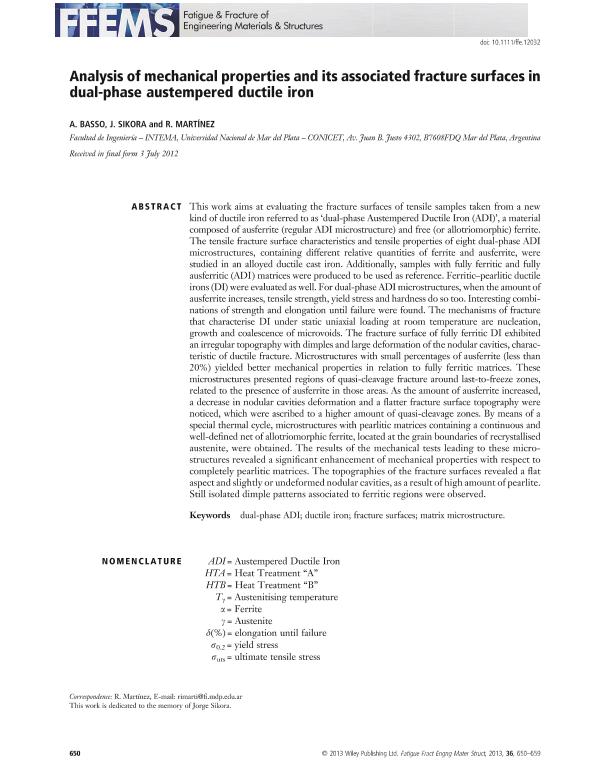Mostrar el registro sencillo del ítem
dc.contributor.author
Basso, Alejandro Daniel

dc.contributor.author
Martinez, Ricardo Antonio

dc.contributor.author
Sikora, Jorge Antonio

dc.date.available
2015-11-12T17:56:36Z
dc.date.issued
2013-04-11
dc.identifier.citation
Basso, Alejandro Daniel; Martinez, Ricardo Antonio; Sikora, Jorge Antonio; Analysis of mechanical properties and its associated fracture surfaces in dual-phase austempered ductile iron; Wiley Blackwell Publishing, Inc; Fatigue & Fracture Of Engineering Materials & Structures (print); 36; 7; 11-4-2013; 650-659
dc.identifier.issn
8756-758X
dc.identifier.uri
http://hdl.handle.net/11336/2758
dc.description.abstract
This work aims at evaluating the fracture surfaces of tensile samples taken from a new kind of ductile iron referred to as ‘dual-phase Austempered Ductile Iron (ADI)’, a material composed of ausferrite (regular ADI microstructure) and free (or allotriomorphic) ferrite. The tensile fracture surface characteristics and tensile properties of eight dual-phase ADI microstructures, containing different relative quantities of ferrite and ausferrite, were studied in an alloyed ductile cast iron. Additionally, samples with fully ferritic and fully ausferritic (ADI) matrices were produced to be used as reference. Ferritic–pearlitic ductile irons (DI) were evaluated as well. For dual-phase ADI microstructures, when the amount of ausferrite increases, tensile strength, yield stress and hardness do so too. Interesting combinations of strength and elongation until failure were found. The mechanisms of fracture that characterise DI under static uniaxial loading at room temperature are nucleation, growth and coalescence of microvoids. The fracture surface of fully ferritic DI exhibited an irregular topography with dimples and large deformation of the nodular cavities, characteristic of ductile fracture. Microstructures with small percentages of ausferrite (less than 20%) yielded better mechanical properties in relation to fully ferritic matrices. These microstructures presented regions of quasi-cleavage fracture around last-to-freeze zones, related to the presence of ausferrite in those areas. As the amount of ausferrite increased, a decrease in nodular cavities deformation and a flatter fracture surface topography were noticed, which were ascribed to a higher amount of quasi-cleavage zones. By means of a special thermal cycle, microstructures with pearlitic matrices containing a continuous and well-defined net of allotriomorphic ferrite, located at the grain boundaries of recrystallised austenite, were obtained. The results of the mechanical tests leading to these microstructures revealed a significant enhancement of mechanical properties with respect to completely pearlitic matrices. The topographies of the fracture surfaces revealed a flat aspect and slightly or undeformed nodular cavities, as a result of high amount of pearlite. Still isolated dimple patterns associated to ferritic regions were observed.
dc.format
application/pdf
dc.language.iso
eng
dc.publisher
Wiley Blackwell Publishing, Inc

dc.rights
info:eu-repo/semantics/openAccess
dc.rights.uri
https://creativecommons.org/licenses/by-nc-sa/2.5/ar/
dc.subject
DUAL-PHASE ADI
dc.subject
DUCTILE IRON
dc.subject
FRACTURE SURFACES
dc.subject
MATRIX MICROSTRUCTURE
dc.subject.classification
Ingeniería de los Materiales

dc.subject.classification
Ingeniería de los Materiales

dc.subject.classification
INGENIERÍAS Y TECNOLOGÍAS

dc.title
Analysis of mechanical properties and its associated fracture surfaces in dual-phase austempered ductile iron
dc.type
info:eu-repo/semantics/article
dc.type
info:ar-repo/semantics/artículo
dc.type
info:eu-repo/semantics/publishedVersion
dc.date.updated
2016-03-30 10:35:44.97925-03
dc.journal.volume
36
dc.journal.number
7
dc.journal.pagination
650-659
dc.journal.pais
Reino Unido

dc.journal.ciudad
Londres
dc.description.fil
Fil: Basso, Alejandro Daniel. Universidad Nacional de Mar del Plata. Facultad de Ingenieria; Argentina. Consejo Nacional de Investigaciones Científicas y Técnicas. Centro Científico Tecnológico Mar del Plata. Instituto de Investigación en Ciencia y Tecnología de Materiales (i); Argentina
dc.description.fil
Fil: Martinez, Ricardo Antonio. Universidad Nacional de Mar del Plata. Facultad de Ingenieria; Argentina. Consejo Nacional de Investigaciones Científicas y Técnicas. Centro Científico Tecnológico Mar del Plata. Instituto de Investigación en Ciencia y Tecnología de Materiales (i); Argentina
dc.description.fil
Fil: Sikora, Jorge Antonio. Universidad Nacional de Mar del Plata. Facultad de Ingenieria; Argentina. Consejo Nacional de Investigaciones Científicas y Técnicas. Centro Científico Tecnológico Mar del Plata. Instituto de Investigación en Ciencia y Tecnología de Materiales (i); Argentina
dc.journal.title
Fatigue & Fracture Of Engineering Materials & Structures (print)

dc.relation.alternativeid
info:eu-repo/semantics/altIdentifier/doi/http://dx.doi.org/10.1111/ffe.12032
dc.relation.alternativeid
info:eu-repo/semantics/altIdentifier/url/http://onlinelibrary.wiley.com/doi/10.1111/ffe.12032/abstract
Archivos asociados
